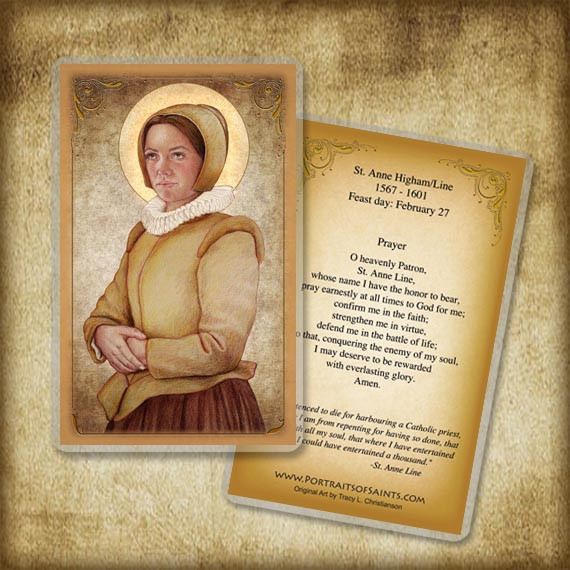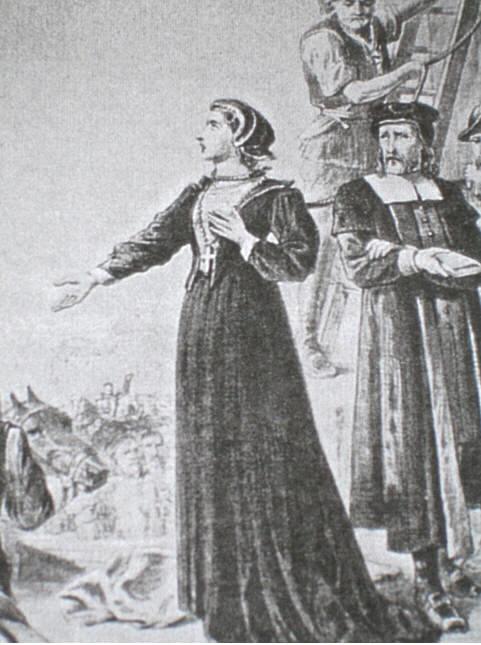Anne Heigham was born at Dunmow (Essex), England, around 1565, the second daughter. Her father was a strict and wealthy Calvinist. In her teens she and her brother, William, became Catholics and were disinherited and disowned by their family. In 1585 she married another disinherited convert, Roger Line. Her husband and her brother were both arrested and imprisoned while attending Mass together. They were fined and eventually banished. This left Anne destitute. Roger Line went to Flanders, where he received a small allowance from the King of Spain, part of which he sent regularly to his wife until his death around 1594. To support herself, Anne taught, embroidered, made vestments and kept house for priests.
Around the same time, Father John Gerard, S.J. opened a house of refuge for hiding priests, and put the newly-widowed Anne Line in charge of it, despite her ill health. By 1597, this house had become insecure, so another was opened, and Anne Line was, again, placed in charge. On 2 February 1601, Fr. Francis Page, SJ, was saying Mass in the house managed by Anne Line, when men arrived to arrest him, having seen a large number of people congregating at the house (for Mass). The priest managed to slip into a special hiding place, prepared by her and afterwards to escape, but she was arrested, along with two other laypeople.
She was tried at the Old Bailey on 26 February 1601. She was so weak that she was carried to the trial in a chair. She told the court that she was so far from regretting having concealed a priest, she only grieved that she “could not receive a thousand more.” Sir John Popham, the judge, sentenced her to hang the next day at Tyburn.
Anne Line was hanged on 27 February 1601. She was executed immediately before two priests, Fr. Roger Filcock, nSJ , her confessor, and Fr. Mark Barkworth, OSB, , though, as a woman, she was spared the disemboweling that they endured. At the scaffold she repeated what she had said at her trial, declaring loudly to the bystanders: “I am sentenced to die for harbouring a Catholic priest, and so far I am from repenting for having so done, that I wish, with all my soul, that where I have entertained one, I could have entertained a thousand.”
It has been argued (by John Finnis and others) that Shakespeare’s poem The Phoenix and the Turtle (Dove) was written shortly after her death to commemorate Anne and Roger Line and that it allegorically takes the form of a Catholic requiem for the couple. The poem is secretly a Catholic eulogy. This argument is linked to claims that Shakespeare was a secret Catholic sympathizer. Like Shakespeare’s couple the Lines had no children.
The Phoenix and the Turtle (Dove) -by William Shakespeare
Let the bird of loudest lay,
On the sole Arabian tree,
Herald sad and trumpet be,
To whose sound chaste wings obey.
But thou, shriking harbinger,
Foul pre-currer of the fiend,
Augur of the fever’s end,
To this troop come thou not near.
From this session interdict
Every fowl of tyrant wing,
Save the eagle, feather’d king:
Keep the obsequy so strict.
Let the priest in surplice white,
That defunctive music can,
Be the death-divining swan,
Lest the requiem lack his right.
And thou, treble-dated crow,
That thy sable gender mak’st
With the breath thou giv’st and tak’st,
‘Mongst our mourners shalt thou go.
Here the anthem doth commence:
Love and constancy is dead;
Phoenix and the turtle (dove) fled
In a mutual flame from hence.
So they lov’d, as love in twain
Had the essence but in one;
Two distincts, division none:
Number there in love was slain.
Hearts remote, yet not asunder;
Distance, and no space was seen
‘Twixt the turtle (dove) and his queen;
But in them it were a wonder.
So between them love did shine,
That the turtle saw his right
Flaming in the phoenix’ sight:
Either was the other’s mine.
Property was thus appall’d,
That the self was not the same;
Single nature’s double name
Neither two nor one was call’d.
Reason, in itself confounded,
Saw division grow together;
To themselves yet either-neither,
Simple were so well compounded
That it cried how true a twain
Seemeth this concordant one!
Love hath reason, reason none
If what parts can so remain.
Whereupon it made this threne
To the phoenix and the dove,
Co-supreme and stars of love;
As chorus to their tragic scene.
THRENOS.
Beauty, truth, and rarity.
Grace in all simplicity,
Here enclos’d in cinders lie.
Death is now the phoenix’ nest;
And the turtle’s loyal breast
To eternity doth rest,
Leaving no posterity:–
‘Twas not their infirmity,
It was married chastity.
Truth may seem, but cannot be:
Beauty brag, but ’tis not she;
Truth and beauty buried be.
To this urn let those repair
That are either true or fair;
For these dead birds sigh a prayer.
St Anne Line Societies are being formed in parishes around the globe for both men and women to assist, support, and pray for our priests.
St Anne Line, pray for married couples. St Anne Line, pray for c
hildless couples. St Anne Line, Protector of Priests, pray for us!
When condemned for harboring a priest, St Anne retorted to the judge, “Pity it wasn’t a thousand!”
Love,
Matthew


